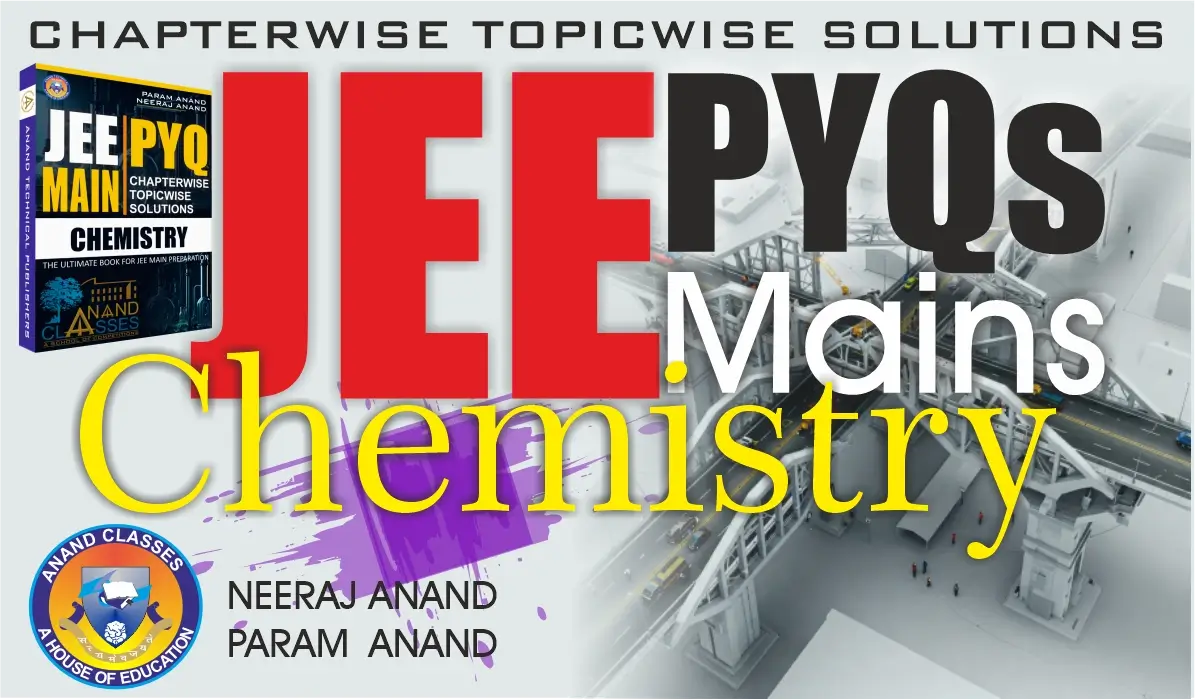Anand Classes provides the most comprehensive Periodic Table Class 11 JEE Main PYQs : MCQs With Solutions PDF Download to help students prepare effectively for competitive exams. This study material includes previous years’ questions, multiple-choice questions (MCQs), and detailed solutions based on the JEE Main syllabus. The notes are designed to strengthen conceptual understanding and boost problem-solving skills for better performance. Click the print button to download study material and notes.
JEE Main 2024 – Relation between Acidic character and Bond dissociation enthalpy – Class 11 Chemistry
JEE Main 2024 Question :
Given below are two statements: One is labelled as Assertion A and the other is labelled as Reason R:
Assertion A: H₂Te is more acidic than H₂S.
Reason R: Bond dissociation enthalpy of H₂Te is lower than H₂S.
In the light of the above statements, choose the most appropriate from the options given below:
(A) Both A and R are true and R is the correct explanation of A.
(B) Both A and R are true but R is NOT the correct explanation of A.
(C) A is false but R is true.
(D) A is true but R is false.
Answer: Correct Option: (A) Both A and R are true and R is the correct explanation of A
Step 1: Analyze the Assertion
- H₂Te is more acidic than H₂S → True.
As we go down the group in Group 16 hydrides, the atomic size increases (S → Te), leading to weaker H–E bonds (E = chalcogen).
Weaker bonds break more easily, releasing H⁺ ions readily. Hence, acidity increases down the group.
Step 2: Analyze the Reason
- Bond dissociation enthalpy of H₂Te is lower than H₂S → True.
Because the H–Te bond is longer and weaker than the H–S bond, it requires less energy to break.
Step 3: Match Assertion and Reason
- The lower bond dissociation enthalpy of H₂Te directly explains why H₂Te is more acidic than H₂S.
- Therefore, both statements are true, and R is the correct explanation of A.
Final Answer
Answer: Correct Option: (A) Both A and R are true and R is the correct explanation of A
Concept Takeaway
- Acidity of hydrides in a group increases down the group due to weaker H–E bonds.
- Lower bond dissociation enthalpy means easier proton release, hence higher acidity.
Understanding acidity trends of hydrides like H₂S, H₂Se, H₂Te is a key part of Class 11 Chemistry and often asked in JEE PYQs. With Anand Classes notes and preparation material on periodic properties, students can strengthen concepts of acidity and bond enthalpies for exams.
JEE Main 2024 – Chemical Reactivity trend in Periodic Table – Class 11 Chemistry
JEE Main 2024 Question :
Given below are two statements:
Statement I: Along the period, the chemical reactivity of the elements gradually increases from group 1 to group 18.
Statement II: The nature of oxides formed by group 1 elements is basic while that of group 17 elements is acidic.
In the light of the above statements, choose the most appropriate from the options given below:
(A) Statement I is False but Statement II is true
(B) Both Statement I and Statement II are False
(C) Statement I is True but Statement II is False
(D) Both Statement I and Statement II are True
Answer: Correct Option: (A) Statement I is False but Statement II is true
Step 1: Analyze Statement I
- Claim: Reactivity gradually increases across the period (Group 1 → 18).
- This is False.
- Group 1 metals (alkali metals) are already highly reactive due to easy electron loss.
- Reactivity decreases towards the middle (transition to less reactive metals and metalloids).
- Reactivity increases again at Group 17 (halogens), which are highly reactive non-metals due to strong tendency to gain electrons.
- Group 18 (noble gases) are largely inert and unreactive.
- Hence, reactivity does not simply “gradually increase” across the period.
Step 2: Analyze Statement II
- Claim: Group 1 oxides are basic, Group 17 oxides are acidic.
- This is True.
- Group 1 elements (e.g., Na, K) form basic oxides such as Na₂O, which reacts with water to give NaOH (a strong base).
- Group 17 elements (halogens) form acidic oxides such as Cl₂O₇, which reacts with water to form HClO₄ (a strong acid).
Final Answer
Answer: Correct Option: (A) Statement I is False but Statement II is true
Concept Takeaway
- Reactivity across a period shows a U-shaped trend: high in Group 1, low near the middle, and high again in Group 17.
- Oxides of metals (left side of periodic table) are basic, while oxides of non-metals (right side) are acidic.
Mastering these periodic trends with Anand Classes notes and JEE PYQs helps students build strong fundamentals for class 11 chemistry, especially in the chapter Periodic Table and Periodicity in Properties.
JEE Main 2024 – Electronic distribution of elements – Class 11 Chemistry
JEE Main 2024 Question :
Match List I with List II.
| List I (Species) | List II (Electronic distribution) |
|---|---|
| (A) Cr$^{2+}$ | (1) $3d^8$ |
| (B) Mn$^{+}$ | (II) $3d^3 4s^1$ |
| (C) Ni$^{2+}$ | (III) $3d^4$ |
| (D) V$^{+}$ | (IV) $3d^5 4s^1$ |
Options:
A: (A)-(III), (B)-(IV), (C)-(I), (D)-(II)
B: (A)-(I), (B)-(II), (C)-(III), (D)-(IV)
C: (A)-(IV), (B)-(III), (C)-(I), (D)-(II)
D: (A)-(II), (B)-(I), (C)-(IV), (D)-(III)
Answer : Correct Option – $$\text{A: (A)-(III), (B)-(IV), (C)-(I), (D)-(II)}$$
Step 1: Determine the electronic configuration of each species
Cr$^{2+}$: Atomic number = 24. Ground state configuration:
$$[\text{Ar}]3d^5 4s^1$$
Remove 2 electrons (4s first, then 3d):
$$\text{Cr}^{2+} : [\text{Ar}]3d^4 \quad \text{matches (III)}$$
Mn$^{+}$: Atomic number = 25. Ground state configuration:
$$[\text{Ar}]3d^5 4s^2$$
Remove 1 electron from 4s:
$$\text{Mn}^{+} : [\text{Ar}]3d^5 4s^1 \quad \text{matches (IV)}$$
Ni$^{2+}$: Atomic number = 28. Ground state configuration:
$$[\text{Ar}]3d^8 4s^2$$
Remove 2 electrons from 4s:
$$\text{Ni}^{2+} : [\text{Ar}]3d^8 \quad \text{matches (I)}$$
V$^{+}$: Atomic number = 23. Ground state configuration:
$$[\text{Ar}]3d^3 4s^2$$
Remove 1 electron from 4s:
$$\text{V}^{+} : [\text{Ar}]3d^3 4s^1 \quad \text{matches (II)}$$
Step 2: Match the species with their corresponding electronic distributions
(A) Cr$^{2+}$ → (III) $3d^4$
(B) Mn$^{+}$ → (IV) $3d^5 4s^1$
(C) Ni$^{2+}$ → (I) $3d^8$
(D) V$^{+}$ → (II) $3d^3 4s^1$
Final Answer
$$\boxed{\text{(A)-(III), (B)-(IV), (C)-(I), (D)-(II)}}$$
Concept Takeaway
Exam Tip: Always remove electrons from the 4s orbital first before 3d when forming cations.
Concept: Understanding the ground state electronic configuration of transition metals helps solve ionic configurations quickly.
Understanding the ground state electronic configuration of transition metals is an essential concept in Class 11 Chemistry and helps in solving JEE PYQs efficiently. Always remember to remove electrons from the 4s orbital before the 3d orbital when forming cations, as this is a common exam tip. This explanation is suitable for students preparing with JEE Main study material, preparation notes, and chapterwise PYQs from Anand Classes.
JEE Main 2024 – Electron gain enthalpy Values – Class 11 Chemistry
JEE Main 2024 Question :
Given below are two statements:
Statement I: Fluorine has the most negative electron gain enthalpy in its group.
Statement II: Oxygen has the least negative electron gain enthalpy in its group.
In the light of the above statements, choose the most appropriate option:
A: Both Statement I and Statement II are true
B: Both Statement I and Statement II are false
C: Statement I is false but Statement II is true
D: Statement I is true but Statement II is false
Answer / Correct Option:
$$\text{C: Statement I is false but Statement II is true}$$
Step 1: Concept explanation
Electron gain enthalpy refers to the energy change when an atom gains an electron. In a group, smaller atoms often experience more interelectronic repulsion, which can make the addition of an electron less favorable, leading to less negative electron gain enthalpy.
Step 2: Identify the elements and their groups
- Fluorine (F) is in Group 17 (halogens) and is very small in size.
- Chlorine (Cl), in the same group, is larger.
- Oxygen (O) is in Group 16 (chalcogens) and is smaller than sulfur (S) in the same group.
Step 3: Compare and analyze
- Statement I: Although fluorine is highly electronegative, its very small size causes significant electron-electron repulsion when gaining an electron. Chlorine, being larger, actually has a more negative electron gain enthalpy. Therefore, Statement I is false.
- Statement II: Oxygen’s small size similarly leads to electron-electron repulsion when gaining an electron, making its electron gain enthalpy less negative than sulfur. Therefore, Statement II is true.
Final Answer:
$$\boxed{\text{Statement I is false but Statement II is true}}$$
Concept Takeaway:
Understanding trends in electron gain enthalpy is important in Class 11 Chemistry and frequently appears in JEE Main PYQs. Smaller atoms often show less negative electron gain enthalpy due to interelectronic repulsion, even if they are highly electronegative. This explanation helps students preparing with JEE Main study material, preparation notes, and chapterwise PYQs from Anand Classes.
JEE Main 2024 – Ionization enthalpy Values – Class 11 Chemistry
JEE Main 2024 Question :
The element having the highest first ionization enthalpy is:
A: C
B: Al
C: Si
D: N
Answer / Correct Option:
$$\text{D: N}$$
Step 1: Concept explanation
First ionization enthalpy is the energy required to remove one electron from a neutral gaseous atom in its ground state. Several factors influence ionization enthalpy:
- Nuclear Charge: Higher nuclear charge increases attraction for electrons, raising ionization enthalpy.
- Atomic Size: Smaller atoms hold valence electrons closer to the nucleus, increasing ionization enthalpy.
- Shielding Effect: Inner electrons reduce the effective nuclear charge on valence electrons, lowering ionization enthalpy.
- Electron Configuration: Half-filled or fully-filled subshells are more stable, making electron removal harder and ionization enthalpy higher.
Step 2: Identify elements and their electronic configurations
- Nitrogen (N): $1s^2 2s^2 2p^3$, half-filled p-subshell, extra stability.
- Carbon (C): $1s^2 2s^2 2p^2$, lacks half-filled stability.
- Silicon (Si): Third period, larger atomic size, more shielding.
- Aluminum (Al): Third period, p-electron easier to remove than s-electron, lower ionization enthalpy than Si.
Step 3: Compare and analyze
Nitrogen’s half-filled p-subshell provides extra stability, making it harder to remove an electron compared to Carbon, Silicon, and Aluminum. As we move down a group, atomic size increases and shielding effect becomes significant, which lowers ionization enthalpy. Therefore, among the given options, Nitrogen has the highest first ionization enthalpy.
Final Answer:
$$\boxed{\text{N}}$$
Concept Takeaway:
Understanding the factors affecting ionization enthalpy, such as nuclear charge, atomic size, shielding effect, and electron configuration, is important in Class 11 Chemistry. The stability of half-filled subshells is a key concept for solving JEE Main questions efficiently. This explanation helps students preparing with JEE Main study material, preparation notes, and chapterwise PYQs from Anand Classes.
JEE Main 2024 – Anomalous behavior of oxygen – Class 11 Chemistry
JEE Main 2024 Question :
The anomalous behavior of oxygen is due to its:
A: large size and low electronegativity
B: small size and high electronegativity
C: small size and low electronegativity
D: large size and high electronegativity
Answer / Correct Option:
$$\text{B: small size and high electronegativity}$$
Step 1: Concept explanation
The anomalous behavior of oxygen refers to its deviation from the general trends observed in Group 16 elements (chalcogens). Factors influencing this anomaly include atomic size, electronegativity, hydrogen bonding, availability of d-orbitals, and ionization energy.
Step 2: Identify the element and its properties
- Oxygen (O): small atomic size, high electronegativity.
- Other Group 16 elements (S, Se, Te) are larger and less electronegative.
Step 3: Compare and analyze
Oxygen’s small size and high electronegativity result in:
- Stronger hydrogen bonding: Oxygen forms strong hydrogen bonds in H₂O, leading to higher boiling point compared to H₂S, H₂Se, etc.
- Absence of d-orbitals: Oxygen cannot expand its octet, unlike heavier group members, limiting it to a maximum of four bonds.
- High ionization energy: Small size and high effective nuclear charge make electron removal harder, contributing to its distinct chemical behavior.
Final Answer:
$$\boxed{\text{small size and high electronegativity}}$$
Concept Takeaway:
Oxygen’s anomalous behavior is primarily due to its small size and high electronegativity. These properties influence hydrogen bonding, octet expansion, and ionization energy, distinguishing oxygen’s chemistry from other Group 16 elements. This explanation is essential for Class 11 Chemistry and helps in solving JEE Main questions efficiently using study material and chapterwise PYQs from Anand Classes.
JEE Main 2024 – Ionization enthalpy trend – Class 11 Chemistry
JEE Main 2024 Question :
Given below are two statements, one labelled as Assertion (A) and the other as Reason (R):
Assertion A: The first ionisation enthalpy decreases across a period.
Reason R: The increasing nuclear charge outweighs the shielding across the period.
Choose the most appropriate option:
A: A is false but R is true
B: Both A and R are true but R is NOT the correct explanation of A
C: Both A and R are true and R is the correct explanation of A
D: A is true but R is false
Answer / Correct Option:
$$\text{A: A is false but R is true}$$
Step 1: Analyze Assertion A
Assertion A states that the first ionisation enthalpy decreases across a period. This is false. As we move across a period in the periodic table, the effective nuclear charge increases while the atomic size decreases. The stronger attraction between the nucleus and outermost electrons requires more energy to remove an electron. Therefore, the first ionisation enthalpy generally increases across a period, with minor exceptions due to electron configurations (e.g., between Group 2 and 13, and Group 15 and 16).
Step 2: Analyze Reason R
Reason R states that the increasing nuclear charge outweighs the shielding across the period. This is true. The number of protons increases as we move across a period, which strengthens the nuclear attraction. Although additional electrons are added, the shielding by inner electrons does not fully compensate for the increased nuclear charge. Consequently, the effective nuclear charge on the valence electrons increases, making them harder to remove.
Step 3: Evaluate the relationship between A and R
Since Assertion A is false but Reason R is true, the correct option is the one that reflects this relationship.
Final Answer:
$$\boxed{\text{A is false but R is true}}$$
Concept Takeaway:
The trend of ionisation enthalpy across a period is a key concept in Class 11 Chemistry and JEE Main questions. It generally increases due to higher effective nuclear charge and decreasing atomic size. Understanding the role of shielding and nuclear attraction helps in predicting and explaining trends in ionisation enthalpy. This explanation is valuable for students using JEE Main study material, preparation notes, and chapterwise PYQs from Anand Classes.
JEE Main 2024 – Electronegativity of Group 14 elements trend – Class 11 Chemistry
JEE Main 2024 Question :
Given below are two statements:
Statement I: The electronegativity of Group 14 elements from Si to Pb gradually decreases.
Statement II: Group 14 contains non-metallic, metallic, as well as metalloid elements.
Choose the most appropriate option:
A: Statement I is false but Statement II is true
B: Both Statement I and Statement II are true
C: Both Statement I and Statement II are false
D: Statement I is true but Statement II is false
Answer / Correct Option:
$$\text{A: Statement I is false but Statement II is true}$$
Step 1: Analyze Statement I
Statement I claims that electronegativity of Group 14 elements from Si to Pb gradually decreases. This is false. Although electronegativity generally decreases down a group due to increasing atomic size and shielding effect, Group 14 exhibits minor fluctuations:
- Germanium (Ge) has slightly higher electronegativity than Silicon (Si)
- Lead (Pb) has slightly higher electronegativity than Tin (Sn)
Therefore, the term “gradually decreases” is not entirely accurate.
Step 2: Analyze Statement II
Statement II says that Group 14 contains non-metallic, metallic, and metalloid elements. This is true. Group 14 elements are:
- Non-metal: Carbon (C)
- Metalloids: Silicon (Si), Germanium (Ge)
- Metals: Tin (Sn), Lead (Pb)
Step 3: Compare and evaluate
Since Statement I is false but Statement II is true, the correct option reflects this relationship.
Final Answer:
$$\boxed{\text{Statement I is false but Statement II is true}}$$
Concept Takeaway:
Understanding the trends of electronegativity and the nature of elements in Group 14 is an important concept in Class 11 Chemistry and for JEE Main preparation. While electronegativity generally decreases down a group, small fluctuations can occur. Recognizing the presence of non-metals, metalloids, and metals in a group helps explain chemical behavior and reactivity trends. This explanation is valuable for students using JEE Main study material, preparation notes, and chapterwise PYQs from Anand Classes.
📚 Buy Study Material & Join Our Coaching
For premium study materials specially designed for JEE, NEET, NDA, and CBSE/ICSE Classes, visit our official study material portal:
👉 https://publishers.anandclasses.co.in/
For NDA Study Material, Click Here
For SSC Study Material, Click Here
To enroll in our offline or online coaching programs, visit our coaching center website:
👉 https://anandclasses.co.in/
📞 Call us directly at: +91-94631-38669
💬 WhatsApp Us Instantly
Need quick assistance or want to inquire about classes and materials?
📲 Click below to chat instantly on WhatsApp:
👉 Chat on WhatsApp
🎥 Watch Video Lectures
Get access to high-quality video lessons, concept explainers, and revision tips by subscribing to our official YouTube channel:
👉 Neeraj Anand Classes – YouTube Channel


